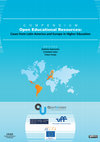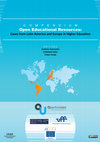Papers by Andreia Inamorato

Open Praxis
Consider for a moment the implications of a solitary existence devoid of openness-an isolated wor... more Consider for a moment the implications of a solitary existence devoid of openness-an isolated world where social relationships, human interaction and communication are anomalies, rather than the norm. Imagining such a bleak, antisocial future illuminates the profound significance of openness, revealing it to be a vital component in our survival toolkit as inherently social beings. While the value of openness in sustaining life is undeniable, its contributions extend far beyond mere survival. Openness serves as an indispensable ingredient in the rich recipe of human learning, development, and progress. It is a truth universally acknowledged that human beings naturally inhabit an open ecosystem, engaging in complex, multifaceted interactions with their environment. Hence, one can make a persuasive argument that openness acts as a potent catalyst, facilitating and invigorating the process of learning. Despite all these benefits of openness and its important role in the learning ecology, it should be noted that institutions create artificial boundaries and insert barriers that oppose and interrupt this openness. However, those of us who wrote this piece resist these artificial barriers and believe in the value of openness. VOICES FROM THE SCHOLARLY LANDSCAPES The chorus of scholarly voices advocating the praxis of Openness in Education continues to grow (Cronin, 2017; Hodgkinson-Williams et al., 2017; Koçdar et al., 2023; Stracke et al., 2023a; Zawacki-Richter et al., 2020), a noble purpose faithfully echoed by the long-established Journal of Open Praxis (Bozkurt & Gil-Jaurena, 2023) and many other journals in the field. Openness in Education is neither a stagnant nor a monolithic concept; it is a fluid, continually evolving ideal, moulded by shifting societal, cultural, geographical, and economic landscapes and, thus, it does not have a precise definition (Bozkurt et al., 2019). Its boundaries are expansive, spanning across myriad dimensions, levels, and layers (

Sustainability, 2022
This paper presents and analyses solutions where open education and open science were utilised to... more This paper presents and analyses solutions where open education and open science were utilised to reduce the impact of the COVID-19 pandemic on education. The COVID-19 outbreak and associated lockdowns created huge challenges in school and higher education, demanding sudden responses which aimed to sustain pedagogical quality. Responses have varied from conservative to radically innovative. Universally, the COVID-19 pandemic disrupted and shocked societies worldwide, and education systems were on the front line. The lockdowns largely stopped face-to-face and formal education in almost all countries, and in most cases, distance learning soon became the ‘new normal’. A central challenge concerned sustaining educational visions and ideals in such circumstances. To better understand the state of the art in the educational landscape, we collected case studies from 13 countries during the first year of the pandemic starting on 11 March 2020 (when the World Health Organization declared a p...

Esta apresentação visa a discutir práticas de avaliação comuns a ambientes de aprendizagem virtua... more Esta apresentação visa a discutir práticas de avaliação comuns a ambientes de aprendizagem virtuais (VLEs) para o ensino de adultos em cursos de pós-graduação. Avaliação pode ser uma ferramenta poderosa para forças contraditórias -tanto para facilitar ensino-aprendizagem como para fazer o papel de "força disciplinar" que irá estabelecer as regras sobre o que pode e deve ser feito numa sala de aula virtual. A maioria dos ambientes de aprendizagem virtuais tem mecanismos para localizar o número de acessos e mensagens postadas pelos alunos. Este tipo de mecanismo, quando usado com o propósito de avaliação , pode ser um causador da dinâmica de relações de poder entre o tutor e os alunos (Land & Bayne, 2001). Outras estratégias de avaliação, como a avaliação em grupo de ensino colaborativo, também podem gerar um clima de vigilância; uma abordagem panoptical para o ensino, que busca a participação e compromisso dos alunos -usando os termos de Foucault (1969). Avaliações e tarefa...

The term Open Educational Resources (OER) was coined in 2002 in discussions at the Forum on the I... more The term Open Educational Resources (OER) was coined in 2002 in discussions at the Forum on the Impact of Open Courseware UNESCO. It describes “the provision of educational resources on open license, enabled by information technologies and communication, for consultation, use and adaptation by a community of users with non-commercial purposes”.In June 2012, Community OER and UNESCO celebrated 10 years in the area of Open World Congress of Educational Resources in Paris, where the Declaration REA Paris 2012 was formally adopted. This calls on governments around the world to establish the adoption of open licenses for sharing knowledge produced with public funds.This trilingual Compendium (written in English, Spanish and Portuguese) aims to fill part of the need for institutionalized information, and aims to discuss in a clear, didactic and realistic way, the experiences of selected higher education institutions who have offered OER. This document provides a unique approach. It combin...

The term Open Educational Resources (OER), the English equivalent of REA, was coined in 2002 in d... more The term Open Educational Resources (OER), the English equivalent of REA, was coined in 2002 in discussions at the Forum on the Impact of Open Courseware UNESCO. It describes "the provision of educational resources on open license, enabled by information technologies and communication, for consultation, use and adaptation by a community of users with non-commercial purposes". However, in the decade since its conception, OER / REA has come to signify not only those shared resources on the Web explicitly with the purpose of contributing to the democratization of knowledge, but in reality, a movement that now has the support of institutions, governments and individuals around the world. sharing of open content on the Web in general, partly due to its emphasis on legal sharing and reuse, done under open licenses (eg , Creative Commons) and more recently due to growing concern over the creation of mechanisms for assessing quality. Large projects such as the MIT OpenCourseWare, OpenLearn of the Open University in the UK, and Connexions of the Rice University, came to join a number of initiatives aiming not only the deployment of repositories for sharing on the Web, but also discussion and collaborative creation reuse practices, research methodologies and benchmarks of quality. The movement in its current form is no longer occupied solely by questions relating to the sharing of resources itself, that is how to ensure interoperability between systems and platforms for sharing, how to approach and solve problems relating to copyright and mainly to ensure its sustainability. Such questions remain, of course, crucial, but more broadly an interest in the new features of Open Education has emerged, which has existed for decades, but now appropriates the OER in various contexts, including for informal learning. Institutionally, OER begins to be known as Open Educational Practices (OEP). In June 2012, Community OER and UNESCO celebrated 10 years in the area of Open World Congress of Educational Resources in Paris, where the OER Paris Declaration 2012 was formally adopted. This calls on governments around the world to establish the adoption of open licenses for sharing knowledge produced with public funds. OER constitutes a fascinating area involving activism, the creation and use of vanguard technologies, and public This is an area in its infancy, but given its intrinsic link with ICTs and their potential impact on education, The Project OportUnidad, co-funded by the European Commission and comprising 12 universities (4 in Europe and 8 in Latin America) aims to bring OER to the educational practices of universities in Latin America. Despite celebrating 10 years of OER globally, it is clear that its concepts are still often unknown or misunderstood, process of formal and informal education. Access to information about existing practices is therefore essential because it allows the continued education of these professionals to enable them to make informed decisions about Compendium-Cases from Latin America and Europe in Higher Education Compendium-Cases from Latin America and Europe in Higher Education

The term Open Educational Resources (OER), the English equivalent of REA, was coined in 2002 in d... more The term Open Educational Resources (OER), the English equivalent of REA, was coined in 2002 in discussions at the Forum on the Impact of Open Courseware UNESCO. It describes "the provision of educational resources on open license, enabled by information technologies and communication, for consultation, use and adaptation by a community of users with non-commercial purposes". However, in the decade since its conception, OER / REA has come to signify not only those shared resources on the Web explicitly with the purpose of contributing to the democratization of knowledge, but in reality, a movement that now has the support of institutions, governments and individuals around the world. sharing of open content on the Web in general, partly due to its emphasis on legal sharing and reuse, done under open licenses (eg , Creative Commons) and more recently due to growing concern over the creation of mechanisms for assessing quality. Large projects such as the MIT OpenCourseWare, OpenLearn of the Open University in the UK, and Connexions of the Rice University, came to join a number of initiatives aiming not only the deployment of repositories for sharing on the Web, but also discussion and collaborative creation reuse practices, research methodologies and benchmarks of quality. The movement in its current form is no longer occupied solely by questions relating to the sharing of resources itself, that is how to ensure interoperability between systems and platforms for sharing, how to approach and solve problems relating to copyright and mainly to ensure its sustainability. Such questions remain, of course, crucial, but more broadly an interest in the new features of Open Education has emerged, which has existed for decades, but now appropriates the OER in various contexts, including for informal learning. Institutionally, OER begins to be known as Open Educational Practices (OEP). In June 2012, Community OER and UNESCO celebrated 10 years in the area of Open World Congress of Educational Resources in Paris, where the OER Paris Declaration 2012 was formally adopted. This calls on governments around the world to establish the adoption of open licenses for sharing knowledge produced with public funds. OER constitutes a fascinating area involving activism, the creation and use of vanguard technologies, and public This is an area in its infancy, but given its intrinsic link with ICTs and their potential impact on education, The Project OportUnidad, co-funded by the European Commission and comprising 12 universities (4 in Europe and 8 in Latin America) aims to bring OER to the educational practices of universities in Latin America. Despite celebrating 10 years of OER globally, it is clear that its concepts are still often unknown or misunderstood, process of formal and informal education. Access to information about existing practices is therefore essential because it allows the continued education of these professionals to enable them to make informed decisions about Compendium-Cases from Latin America and Europe in Higher Education Compendium-Cases from Latin America and Europe in Higher Education
Uploads
Papers by Andreia Inamorato